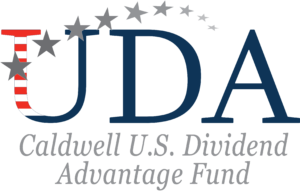For the month of April, the Caldwell U.S. Dividend Advantage Fund (“UDA”) declined 2.6% versus a decline of 6.6% for the S&P 500 Total Return Index (“Index”)1. Consumer Staples, Energy and Materials were top performing sectors while Communication Services, Consumer Discretionary and Information Technology ("IT") were relative underperformers. A weakening macro outlook prompted investors to rotate into more defensive sectors, such as Consumer Staples, while Energy and Materials companies continue to benefit from high commodity prices, partially related to supply shortages brought on by Russia's invasion of Ukraine. UDA benefited during the month from an overweight position in the Energy sector relative to its benchmark. The prospect of softening consumer spending and shrinking advertising budgets weighed on most of the mega-cap tech names that hold significant weights in the underperforming sectors noted above.
Top performers in the month of April were Coterra Energy ("CTRA", +9.2%), UnitedHealth ("UNH", +2.0%) and Dollar General ("DG", +9.4%)2. CTRA continued to benefit from higher oil and natural gas prices over the month. Given recent earnings releases, capital spending discipline and management team guidance in the sector, we believe current supply-and-demand dynamics should support higher energy prices for the foreseeable future. In addition to capital spending discipline, many Energy companies (including CTRA) are also holding true to their promise of improving shareholder returns, which has led to material dividends/buybacks increases across the sector over the last few months. UnitedHealth beat analysts’ expectations and raised full year guidance in their first quarter results. We believe the steady string of results throughout the pandemic highlights UNH's competitive advantage of integrating all areas of patient care under one roof to drive sustainably growing profitability. Lastly, the transition to value-based care is still early stage, underpinning a solid growth runway over mid to long term. DG is a well-managed discount store chain with 16,000 locations that are within five minutes of 75% of the U.S. population. Relative to the 2008-2009 period, the company is better-positioned to capture wallet and market share given expanded product offerings, competitive closures/bankruptcies, relative price advantage vs. other discount peers and investments to bring more of the supply chain in-house. Ultimately, we believe DG is well positioned to outperform in a consumer trade down environment.
Rising rates and inflation continue to dominate the market narrative, especially since the former poses a risk to higher multiple stocks that currently have an outsized weighting in major market benchmarks. However, given its unique momentum-driven investment approach and focus on well-managed, dividend growth companies, we believe UDA is well positioned to provide strong performance by way of both attractive regular monthly distributions and long-term capital appreciation potential. We expect that dividend growth investing, which has been foundational to the Fund’s investment approach, will continue to provide a means of generating compelling risk-adjusted returns for our investors over the long term.
1Standard performance as at April 30, 2022:
Caldwell U.S. Dividend Advantage Fund Series F: 1 Year: 3.7%, 3 year: 8.3%, 5 year: 7.2%, Since Inception (June 19, 2015): 8.5%.
S&P500 Total Return Index: 1 Year: 4.1%, 3 year: 11.9%, 5 year: 12.1%, Since Inception (June 19, 2015): 13.1%.
2Actual investments, first purchased: CTRA 10/14/2021, DG 7/27/2020, UNH 12/2/2015.
All data is as of April 30, 2022 sourced from Morningstar Direct or S&P Capital IQ, unless otherwise indicated. Fund returns are from FundData. UDA, Index total return numbers, sector returns and individual stocks returns are in CAD terms. The Fund was first offered to the public as a closed-end investment since May 28, 2015. Effective November 15, 2018 the Fund was converted into an open-end mutual fund such that all units held were redesignated as Series F units. Performance prior to the conversion date would have differed had the Fund been subject to the same investment restrictions and practices of the current open-end mutual fund.
The information contained herein provides general information about the Fund at a point in time. Investors are strongly encouraged to consult with a financial advisor and review the Simplified Prospectus and Fund Facts documents carefully prior to making investment decisions about the Fund. Commissions, trailing commissions, management fees and expenses all may be associated with mutual fund investments. Rates of returns, unless otherwise indicated, are the historical annual compounded returns including changes in unit value and reinvestment of all distributions and do not take into account sales, redemption, distribution or optional charges or income taxes payable by any unitholder that would have reduced returns. Mutual funds are not guaranteed; their values change frequently and past performance may not be repeated. The payment of distributions should not be confused with a fund’s performance, rate of return or yield. If distributions paid are greater than the performance of the fund, your original investment will shrink. Distributions paid as a result of capital gains realized by a fund, and income and dividends earned by a fund, are taxable in your hands in the year they are paid. Your adjusted cost base (“ACB”) will be reduced by the amount of any returns of capital and should your ACB fall below zero, you will have to pay capital gains tax on the amount below zero.
Publication date: May 11, 2022.

